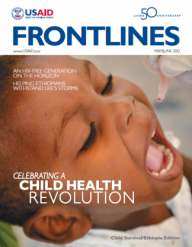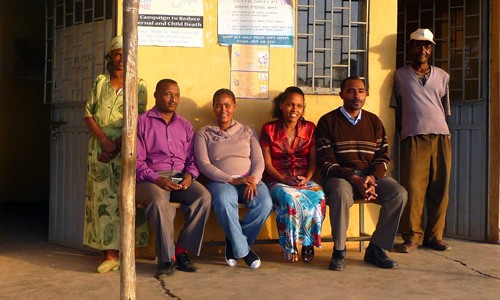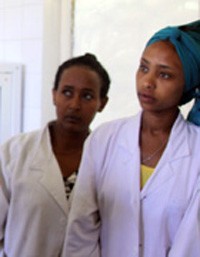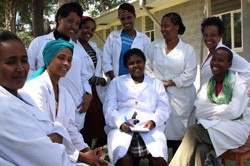 A mother holds her child at their “model home” in a village outside Enticho Tigray, Ethiopia, served by the Endamariam Health Post.
Nena Terrell, USAID
A mother holds her child at their “model home” in a village outside Enticho Tigray, Ethiopia, served by the Endamariam Health Post.
Nena Terrell, USAID
 A mother holds her child at their “model home” in a village outside Enticho Tigray, Ethiopia, served by the Endamariam Health Post.
Nena Terrell, USAID
A mother holds her child at their “model home” in a village outside Enticho Tigray, Ethiopia, served by the Endamariam Health Post.
Nena Terrell, USAID
Ethiopia, Africa’s second most populous nation, is also overwhelmingly rural. Bucking the global trend of mass migration to cities, over 80 percent of Ethiopians still live in hard-to-reach areas. This isolation presents a formidable challenge for the government’s health sector, which, to complicate matters further, suffers from a severe shortage of doctors and health professionals. In a country of over 80 million, there are only 2,152 physicians—one for every 36,000 people.
Around a decade ago, the infant mortality rate in Ethiopia was nearly 10 percent, and the rate of those dying before their fifth birthday topped 16 percent, both statistics among the world’s highest. At a time when world leaders were gathering to set ambitious targets to raise the bar on global health with the Millennium Development Goals, Ethiopia’s numbers demanded attention.
And while progress in child health has been made—over the past five years, the under-5 mortality rate has decreased by 28 percent, from 123 to 88 deaths per 1,000 live births—the Ethiopian Government still considers the death rate intolerably high as one in 11 children today still do not live beyond their fifth birthday.
Finding answers to several questions was considered central to making greater gains: How do you bring quality health services to rural villages? How do you empower families to take charge of their own health? How do you encourage pregnant women to seek preventive care and dissuade them from potentially dangerous home deliveries? After babies are born, how do you ensure they are fed properly, and are vaccinated to survive those tenuous first months and years of life? How do you give mothers the information they need to improve their family’s health, including the benefits of birth spacing? When government-sponsored care is available, how do you encourage deeply traditionally people to use it?
While these basic questions barely warrant a second look within developed health systems, to the Ethiopian Health Ministry, they often represent a matter of life and death.
Women at the Center
The government’s response, according to Ethiopian Health Minister Tedros Adhanom Ghebreyesus, has been to methodically construct a “women-centered” health system “by linking leaders at the national, regional and district levels with women’s groups in every village across the country.”
The plan was officially rolled out in 2003 in the form of the landmark Health Extension Program (HEP). The government would first train a fleet of young women for a year to provide basic, largely preventive, primary health services to rural villages, and then deploy them in pairs around the country to alert communities to unhealthy practices and empower families to take charge of their own health. The program was designed to tackle both the rural access problem and the health-sector workforce gap.
The HEP works like a countrywide referral network, rippling up from its foundation at rural health posts (home base for the extension workers), to the larger, better-equipped health centers, each serving around 25,000 people. At the top of the pyramid are the country’s 122 hospitals, each staffed with at least one doctor.
Additionally, as of last year, Ethiopia’s front line—the health extension workers—began to count on even deeper levels of grass-roots support when the government-named “Women’s Development Army” was formed. These community-level volunteers are trained by the health extension workers to focus more intensively on sparking local behavior change. They make regular rounds to check on neighbors and encourage practices like latrine building and setting-up separate cooking spaces. They are from “model families” and serve as living examples that the health extension workers’ messages are being heard.
“These model families influence other families to follow suit, and the changes seen at the community level are phenomenal,” says Jeanne Rideout, health team leader for USAID/Ethiopia, which funds the Integrated Family Health Program (IFHP), a five-year project providing technical, managerial and financial support to the Health Extension Program.
The government has a lot riding on this network of women. “These development teams are being empowered to monitor health and well-being. Through the aggressive social mobilization of this massive army of health extension workers and local development teams, we are determined to bring about the fundamental grassroots change needed to achieve our MDG targets,” wrote Tedros in the forward to the Health Sector Development Plan IV, the government’s road map to improving health in the next five years.
Health from the Grassroots
Wubalem Bezabih, 25, and Fetelwork Gezahegn, 28, are two of the roughly 35,000 health extension workers the government has trained under the program to date. Their base camp, Remeda Health Post in the Southern Nations, Nationalities, and People’s Region (SNNPR) of Ethiopia, is a small concrete structure. From there, the women provide basic primary health care and outreach for around 5,000 villagers.
Managing the post involves rotating on daily foot patrols to educate villagers on basic practices and services that are often lifesaving interventions in rural communities. “The really basic things are what’s most important for the rural people; in other words, vaccinations, antenatal care, sanitation, nutrition—helping people to understand the importance of hand washing; simple malaria prevention like bed nets and spraying; and the need for pit latrines,” says USAID/Ethiopia Mission Director Tom Staal. “This is what health extension workers can do. They’re not doctors. But just these basic interventions can help prevent 90 percent of health-care issues for most families.”
Bezabih and Gezahegn display the books where they meticulously record the day’s interventions—the number of children who presented with fever, diarrhea or cough that month; how many women sought family planning and how many are educated on it; how many children were screened and treated for slow growth; and a directory of their area’s pregnant women and their check-up schedules.
Throughout the country, including in the six regions where IFHP supports the Health Extension Program, all health extension workers record and report data in the same way, facilitating the government’s ability to measure progress.
The women boast about their accomplishments: “In this kebele [Ethiopia’s smallest administrative area], malnutrition has gone down. There have only been four cases out of 1,012 kids,” explains Gezahegn. Challenges persist, however. Because this health outpost has no running water, the health extension workers often haul it on foot. “Sometimes you get tired,” Bezabih admits. “When you get to a rural home and the people are not there.”
Many of the country’s extension workers are trained to perform clean deliveries. In November 2011, Bezabih and Gezahegn safely delivered three babies. Their goal, however, is to encourage the community’s women to make the 3-kilometer journey to the more sophisticated health center where mothers and infants have a better chance of surviving a complicated delivery.
The Ripple Effect
At the second rung of the HEP are the health centers, managed by the equivalent of physician assistants who go through three years of state-sponsored training. At the Buge Health Center, in Damot Gale woreda in SNNPR, 27-year-old Ayelech Getachew oversees 24 staff. The resident health officer explains that, like the health extension workers she works closely with, a large part of her staff’s job involves convincing the surrounding populations to use their services. “Before our community sensitization and training, they explain, 10 or 11 women came here to deliver per month. Now it’s 25,” she said.
Like most health centers, Buge now boasts a trained midwife, deployed as part of a new government initiative to provide a skilled birth attendant at each center. Twenty-five-year-old midwife Kasech Negash enters the Buge antenatal room and explains that the health center staff encourage women to make at least four visits to the health center before delivery.
Zergu Tafese, IFHP’s manager for SNNPR, explains just one of the harmful deep-seated practices midwives and health officers are trying to curb. “Traditionally, in Ethiopia, people used to [wash] newborn babies in cold water. Midwives are counseling mothers to delay baby washing for at least one day,” he explains.
Adding to these health professionals’ ever-growing arsenal of skills and knowledge, IFHP, implemented by USAID partners Pathfinder and John Snow Inc., recently sponsored training in integrated management of newborn and childhood illnesses, which addresses all major causes of child death in an integrated fashion. Now one provider can treat respiratory infections, malaria or diarrhea as well as screen for malnutrition in a single visit. The center also offers women information about various methods of contraception that can help limit the size of their families. “Anyone coming for family planning gets HIV tests,” Getachew adds.
It is this kind of integrated care—promoted by health-care professionals up and down the referral network—that is the lynch pin of USAID support to the Ethiopian Government’s efforts to reform the health sector countrywide, as well as to the Obama administration’s greater Global Health Initiative worldwide.
Boosting Health Center Coffers
Ethiopia has over 80 million people to care for, but only modest government revenues to finance health care. In fact, the Ethiopian Government pays only around 20 percent of the total costs of providing care in the country, while international donors pick up over 40 percent with the rest coming out of patients’ pockets.
For the past decade, USAID has been working closely with the Ethiopian Government to reform the way health care is financed in the country, moving away from its chronically underfunded, centralized model of support. A major success has been registered in the area of health-care financing.
“What we did over a period of five years was help to get [the government] aware and comfortable with allowing health centers and, in some cases, hospitals, to collect fees—very minimal, but certain fees for certain non-life-saving interventions,” says USAID Mission Director Tom Staal.
“So there is now a small consultation fee roughly equivalent to 50 cents at health centers and one dollar at a hospital to pay for items like aspirin, a blood test and certain basic services,” he explains, although there are complete waivers for the extreme poor.
The program, which was first rolled out in 2004 in the Southern Nationalities, Nations and Peoples’ Region (SNNPR) but is now implemented to some extent in all of Ethiopia’s regions and city administrations, has three elements: permitting the country’s health facilities to collect fees; allowing the health facility to keep that money (without losing their government revenue); and helping the centers make strategic use of the funds by involving the community in local governance boards.
Staal explains: “We worked with the government to set up a committee that includes officials from the facility, local government officials, and a community member to manage the fees by agreeing on approved expenses. What we found is that they were able to use those funds to upgrade facilities—put in a water tank, a generator for electricity, clean up the facilities, fix the broken windows, some additional staff training.”
What happened next, explains Staal, follows the logical supply-demand paradigm: Since quality of care has improved, more people sought out care, closing the utilization gap that has been a major challenge to improving health care in the country. With rising numbers of patients, the health centers took in more revenue.
“At one health care facility I visited recently,” says Staal, “they were saying that they were actually able to hire specialists at the hospital, which they could never afford before. And they were able to pay them at a salary rate higher than the government rate. So that’s pretty exciting for a rural hospital to be able to get that sort of specialty,” he says, especially considering that Ethiopia is one of a number of countries categorized as having a health-sector workforce crisis.
Other health centers, like Buge Health Center in the SNNPR, have used extra funds to expand their labor services. “We have seen significant improvements in the quality of service recently,” says supervising Health Officer Ayelech Getachew. “Before we had no oxytocin,” she says of the drug to prevent post-partum hemorrhage, a major killer during childbirth. “After we were trained by the Integrated Family Health Program on how to use it, we purchased it with the money we retained from provision of services.”
“This is really turning things around,” says Staal.
Treating the Person, Not the Disease
As one of the two largest bilateral donors to Ethiopia’s health system (the other is the U.K. Department for International Development), USAID is also the largest supporter of its effort to integrate a vast number of diverse but desperately needed services under one umbrella.
USAID/Ethiopia’s Integrated Family Health Program was launched in 2008 as an effort to bridge and streamline two separate programs, one concentrated on child health and the other on reproductive health. Today it operates in six of Ethiopia’s nine regions and 283 districts, or woredas, covering almost 32 million people. At its core, the program supports the government’s mission to offer the country’s women, who are the primary caretakers in Ethiopian society, a range of health and education services—including maternal, newborn and child health, and family planning—as a package deal.
“Integration means addressing all a person’s health concerns in one visit. Before, if a woman brought her child for immunization, a provider would not necessarily ask her about family planning, or screen her child for poor growth,” says USAID’s Rideout. “Now, health services are set up to address all the person’s needs, not just the issue that initially brought them to the facility.”
Ambitious Targets
Although Ethiopians still face a wide range of development challenges, including access to safe water and sanitation; and in some areas, harmful traditional practices such as female genital mutilation and early marriage, health-sector reform is starting to transform peoples’ lives, especially in the area of child health.
Between 2000 and 2010, the under-5 mortality rate was cut in half, from 166 deaths per 1,000 live births to 88.
Contraceptive use in this time period nearly quadrupled. Although Ethiopian women still have an average of 4.8 children each, the total fertility rate is down from 6.4 in 1990 and 5.4 in 2005.
The Health Ministry’s initiative to train 9,000 skilled midwives and deploy them to health centers by 2015 is expected to continue to bring maternal, infant, and child morbidity and mortality numbers down further as the battalion of female health professionals grows and gets trained.
And importantly, the Women’s Development Army—the force of community-based volunteers—is continuing its advance. “It is now taking over much of the education function that the health extension workers used to do, because the volunteers are such staunch believers in the process,” says Rideout.
The Ethiopian Government is not settling for mild success. It has set ambitious targets for maternal and child health for the five-year period from 2011 to 2015. Among its targets are bringing maternal mortality down from 676 to 267 per 100,000 live births and further reducing under-5 mortality rates from 88 to 67 per 1,000.
Transforming Care for the Rural Millions
Although the Heath Extension Program is less than a decade old, it has brought basic health care within reach of some 67 million rural residents for the first time: Roughly 85 percent of the population is covered.
“Up until about six years ago, the vast majority of Ethiopians had no access to a health facility of any kind,” says Staal.
The number of health centers has quadrupled from 668 to under 3,000 over the past five years, and the number of health posts has more than doubled over the past six years to over 15,000. As Ethiopians receive more reliable health care, and learn to use it more dependably, heath indicators are expected to follow suit.
Staal credits Ethiopian Health Minister Dr. Tedros Adhanom as the general behind the health army’s rise: “He’s a dynamic guy, a real visionary, a real leader … and is internationally recognized. When it comes to the Health Extension Program, it’s been his vision and his determination to make it happen that has ignited so much success.”
USAID has been behind the Health Ministry every step of the way. The Agency has supported health-worker training and implementation of integrated care up and down the referral chain, especially at the community level. U.S. Government health-sector support in 2010 also provided crucial medicines, vaccinations and supplies as well as management and infrastructure support for the ministry nationwide.
Tedros calls the relationship a functioning partnership, mainly because the United States is supporting the Ethiopian Government’s own priorities. “We set where we would like to be and how to get there. And I’m really glad that USAID supports us based on that: It is helping us actually to make progress and to get good results,” he says, adding: “When I work with USAID, we focus on two things. One is saving lives now, but at the same time we are building the system for the future. Our partnership has been based on this understanding, and it has been key to our progress.”













Comment
Make a general inquiry or suggest an improvement.